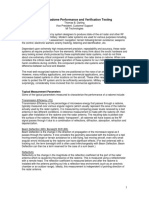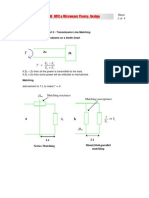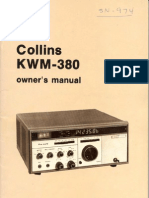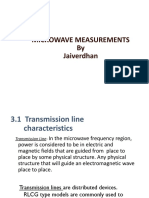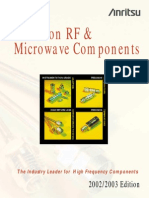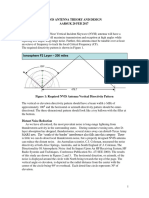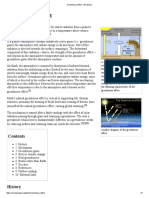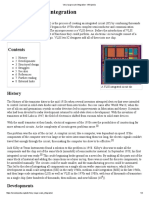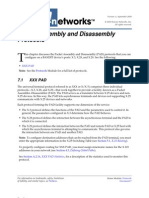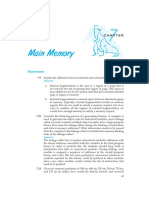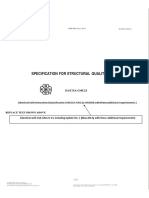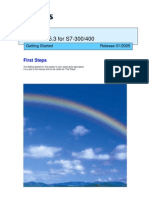VSWR
VSWR
Uploaded by
Biswajit MohantyCopyright:
Available Formats
VSWR
VSWR
Uploaded by
Biswajit MohantyCopyright
Available Formats
Share this document
Did you find this document useful?
Is this content inappropriate?
Copyright:
Available Formats
VSWR
VSWR
Uploaded by
Biswajit MohantyCopyright:
Available Formats
1/24/2014
VSWR
VSWR (Voltage Standing Wave Ratio)
Antenna Definitions Antenna Theory For a radio (transmitter or receiver) to deliver power to an antenna, the impedance of the radio and transmission line must be well matched to the antenna's impedance. The parameter VSWR is a measure that numerically describes how well the antenna is impedance matched to the radio or transmission line it is connected to. VSWR stands for Voltage Standing Wave Ratio , and is also referred to as Standing Wave Ratio (SWR). VSWR is a function of the reflection coefficient, which describes the power reflected from the antenna. If the reflection coefficient is given by , then the VSWR is defined by the following formula:
The reflection coefficient is also known as s11 or return loss. See the vswr table below to see a numerical mapping between reflected power, s11 and VSWR. If you don't want to go through complicated equations to understand the relationship between VSWR, mismatch loss, s11/gamma and would like a calculator to do it for you, check out our VSWR calculator page and we'll do the VSWR conversion for you. The VSWR is always a real and positive number for antennas. The smaller the VSWR is, the better the antenna is matched to the transmission line and the more power is delivered to the antenna. The minimum VSWR is 1.0. In this case, no power is reflected from the antenna, which is ideal. Often antennas must satisfy a bandwidth requirement that is given in terms of VSWR. For instance, an antenna might claim to operate from 100-200 MHz with VSWR<3. This implies that the VSWR is less than 3.0 over the specified frequency range. This VSWR specifications also imples that the reflection coefficient is less than 0.5 (i.e., <0.5) over the quoted frequency range.
Physical Meaning of VSWR
VSWR is determined from the voltage measured along a transmission line leading to an antenna. VSWR is the ratio of the peak amplitude of a standing wave to the minimum amplitude of a standing wave, as seen in the following Figure:
http://www.antenna-theory.com/definitions/vswr.php
1/5
1/24/2014
VSWR
Figure 1. Voltage Measured Along a Transmission Line. In industry, VSWR is sometimes pronounced "viz-wer". When an antenna is not matched to the receiver, power is reflected (so that the reflection coefficient, , is not zero). This causes a "reflected voltage wave", which creates standing waves along the transmission line. The result are the peaks and valleys as seen in Figure 1. If the VSWR = 1.0, there would be no reflected power and the voltage would have a constant magnitude along the transmission line.
VSWR, Reflected Power, and s11
Is a VSWR of 3 bad? How bad is a VSWR of 12? Well, there are no hard rules. In this section, we'll try to put the VSWR number in context. Below is a table showing the relationship between VSWR, total reflected power, and (also known as s11), and total reflected power. Note that the reflected power is simply the reflection coefficient ( ) squared. Table I. VSWR, Reflected Power, and
VSWR 1.0 1.5 2.0 2.5 3.0 3.5 4.0 5.0 6.0
http://www.antenna-theory.com/definitions/vswr.php
(s11)
(s11) 0.000 0.200 0.333 0.429 0.500 0.556 0.600 0.667 0.714 0.750
Reflected Power (%) Reflected Power (dB) 0.00 4.0 11.1 18.4 25.0 30.9 36.0 44.0 51.0 56.3 -Infinity -14.0 -9.55 -7.36 -6.00 -5.10 -4.44 -3.52 -2.92 -2.50
2/5
7.0
1/24/2014
7.0 8.0 9.0 10.0 15.0 20.0 50.0
0.750 0.778 0.800 0.818 0.875 0.905 0.961
VSWR
56.3 60.5 64.0 66.9 76.6 81.9 92.3
-2.50 -2.18 -1.94 -1.74 -1.16 -0.87 -0.35
In the above table, a VSWR of 4 has 36% of power delivered by the receiver reflected from the antenna (64% of the power is delivered to the antenna). Note that a reflected power of 0 dB indicates all of the power is reflected (100%), whereas -10 dB indicates 10% of the power is reflected. If all the power is reflected, the VSWR would be infinite. Note that VSWR is a highly non-linear function of the reflection coefficient . That is, there is very little difference in reflected power when the VSWR increases from 9 to 10; however there is an 11% change in reflected power when the VSWR changes from 1 to 2. In general, if the VSWR is under 2 the antenna match is considered very good and little would be gained by impedance matching. As the VSWR increases, there are 2 main negatives. The first is obvious: more power is reflected from the antenna and therefore not transmitted. However, another problem arises. As VSWR increases, more power is reflected to the radio, which is transmitting. Large amounts of reflected power can damage the radio. In addition, radios have trouble transmitting the correct information bits when the antenna is poorly matched (this is numerically defined in terms of another metric, EVM - Error Vector Magnitude).
VSWR Specs for Antennas
Often in industry, antennas are screened (pass/fail criteria) based on VSWR specifications (VSWR specs). This is a method of measuring the antennas passively to determine if they are properly tuned in a quick manner. The antenna is measured with a network analyzer, and the VSWR as a function of frequency is recorded. As an example, consider this situation where the VSWR of 5 antennas are measured and plotted, along with 4 lines that represent the VSWR specs for this antenna (in blue):
http://www.antenna-theory.com/definitions/vswr.php
3/5
1/24/2014
VSWR
Figure 2. Plot of 5 antennas VSWR versus Frequency. The VSWR specs in Figure 2 are defined by: (1) VSWR < 3.8 for 825MHz < f < 910 MHz (2) VSWR > 4.0 for 1200MHz < f < 1400 MHz (3) VSWR > 3.0 at f = 1.7 GHz, linearly reduced to VSWR > 2.0 at f = 1.8 GHz (4) VSWR < 3.0 for 1860MHz < f < 2000 MHz In Figure 2, the red VSWR curve antenna would fail the second spec, and the light blue VSWR curve antenna would (marginally) fail the fourth specification. This is illustrated in Figure 3:
http://www.antenna-theory.com/definitions/vswr.php
4/5
1/24/2014
VSWR
Figure 3. VSWR specs and the VSWR Curves. Setting VSWR specs is a somewhat tricky job for antenna engineers. The idea is to fail the outliers (detuned antennas or antennas with broken connectors, etc). However, it is difficult in practice to determine what the acceptable variance is, particularly in high-volume industries where a tight spec could fail thousands of good antennas. Note that VSWR is a measure of how much power is delivered to an antenna. This does not mean that the antenna radiates all the power it receives. Hence, VSWR measures the potential to radiate. A low VSWR means the antenna is well-matched, but does not necessarily mean the power delivered is also radiated. An anechoic chamber or other radiated antenna test is required to determine the radiated power. VSWR alone is not sufficient to determine an antenna is functioning properly. VSWR can also be measured on the Smith Chart. VSWR is only a scalar measurement, whereas the Smith Chart shows both magnitude and phase. See the Smith Chart page for more details. Top: VSWR Antenna Definitions Home: Antenna-Theory.com (Home)
This page on VSWR (Voltage Standing Wave Ratio) is copyrighted. No portion can be reproduced except by permission from the author. Copyright antenna-theory.com, 2009-2013, VSWR.
http://www.antenna-theory.com/definitions/vswr.php
5/5
You might also like
- NSI-MI - Military Radome Performance and Verification TestingDocument7 pagesNSI-MI - Military Radome Performance and Verification TestingKashif KhalilNo ratings yet
- The Complete Smith ChartDocument8 pagesThe Complete Smith ChartMohammed AbulmakaremNo ratings yet
- Antenna Tutorials - Reflection Coefficient and VSWRDocument5 pagesAntenna Tutorials - Reflection Coefficient and VSWREmilio Escalante100% (1)
- Return Loss and VSWR With Formula-01Document6 pagesReturn Loss and VSWR With Formula-01Adit Haqy100% (1)
- NanoVNA Calibration Considerations and Procedure - v1.1Document10 pagesNanoVNA Calibration Considerations and Procedure - v1.1Jesus GonzalezNo ratings yet
- 06Document20 pages06Xuongrong CatNo ratings yet
- Gamma-Matching Networks: How ToDocument10 pagesGamma-Matching Networks: How ToDavid CasasNo ratings yet
- Loop Antenna PDFDocument20 pagesLoop Antenna PDFOmar F'KassarNo ratings yet
- Zs6bkw Vs G5rv 20100221bDocument96 pagesZs6bkw Vs G5rv 20100221bStathis MaliakisNo ratings yet
- AWP (Antenna Measurement) PDFDocument94 pagesAWP (Antenna Measurement) PDFAdiseshuMiddeNo ratings yet
- PC-ALE Radio ControlDocument47 pagesPC-ALE Radio ControlJorge Felippe A. CostaNo ratings yet
- Gain of Directional Antennas-John E - Hill-Watking-Johnson (1976)Document14 pagesGain of Directional Antennas-John E - Hill-Watking-Johnson (1976)gereborchNo ratings yet
- Antenna Matching TechniquesDocument3 pagesAntenna Matching TechniquesArut SelvanNo ratings yet
- Quality Factor of Inductor and CapacitorDocument4 pagesQuality Factor of Inductor and CapacitoradimeghaNo ratings yet
- Easy To Build Deltaloop Für 27.555Mhz (11M) : From Dl5Dbm, Anwar Von Sroka. Main Information From Antenna-Book RothammelDocument1 pageEasy To Build Deltaloop Für 27.555Mhz (11M) : From Dl5Dbm, Anwar Von Sroka. Main Information From Antenna-Book Rothammeladel agustiNo ratings yet
- Smith Chart Part 2Document4 pagesSmith Chart Part 2api-3823128No ratings yet
- QP MICROWAVE Bias TeesDocument2 pagesQP MICROWAVE Bias TeesTribu Vaquero JimenezNo ratings yet
- Smith ChartDocument41 pagesSmith ChartBhavin V Kakani100% (1)
- Twisted Pair Transmission Line Distributed Parametrs PDFDocument8 pagesTwisted Pair Transmission Line Distributed Parametrs PDF임광식0% (1)
- 01B Balun - Reflections 2nd Edition Chapter 21 - Some Aspects of The Balun Problem (By Walter Maxwell W2DU)Document15 pages01B Balun - Reflections 2nd Edition Chapter 21 - Some Aspects of The Balun Problem (By Walter Maxwell W2DU)Fernando Martin100% (1)
- 3m47 Emerson Cuming1Document6 pages3m47 Emerson Cuming1viveknarula295382No ratings yet
- Low Band DX Antennas (On A Small Lot)Document24 pagesLow Band DX Antennas (On A Small Lot)christarnovskyNo ratings yet
- HF Antennas For All Locations - L. A. Moxon - 1982Document272 pagesHF Antennas For All Locations - L. A. Moxon - 1982comprasNo ratings yet
- EMI Shielding Methods and Materials A ReDocument14 pagesEMI Shielding Methods and Materials A ReWiga Vicky IrawanNo ratings yet
- Antenna Theory - Short Dipole - Tutorialspoint PDFDocument3 pagesAntenna Theory - Short Dipole - Tutorialspoint PDFSukhada Deshpande.100% (1)
- Antenner Tuner - Cg3000NDocument5 pagesAntenner Tuner - Cg3000Nmark777mark0% (1)
- Introduction To HF by Charlie Davy - M0PZTDocument15 pagesIntroduction To HF by Charlie Davy - M0PZTBlagoja GjakovskiNo ratings yet
- Homebrew BuddipoleDocument10 pagesHomebrew Buddipole10sd156No ratings yet
- Handbook TestingDocument34 pagesHandbook TestingGUDDUNo ratings yet
- Article Antenna Magloop Gamma 6MW PDFDocument19 pagesArticle Antenna Magloop Gamma 6MW PDFRahman EffendiNo ratings yet
- Operator's Manual For Collins MP-20 Radio SetDocument27 pagesOperator's Manual For Collins MP-20 Radio Setm38a1guy100% (1)
- Smith Chart Part 1Document13 pagesSmith Chart Part 1api-3823128No ratings yet
- VSWR TestDocument3 pagesVSWR Testعبدالرحمن عبدالله قاسم100% (1)
- Microwave Filter Cross - CouplingDocument12 pagesMicrowave Filter Cross - Couplingmojingyan100% (1)
- ETS-Lindgren - AMS-8100 Antenna Measurement System - NIT PuneDocument20 pagesETS-Lindgren - AMS-8100 Antenna Measurement System - NIT PuneRajarshi BhattacharyaNo ratings yet
- Collins KWM-380 Owner's Manual 2nd Edition 1 January 1981 (SM)Document49 pagesCollins KWM-380 Owner's Manual 2nd Edition 1 January 1981 (SM)cmaukonen00No ratings yet
- Setting Up An RF Test and Calibration LaboratoryDocument16 pagesSetting Up An RF Test and Calibration LaboratoryVan D ManNo ratings yet
- Microwave MeasurementDocument56 pagesMicrowave MeasurementIndraysh Vijay [EC - 76]No ratings yet
- Anritsu PartsDocument80 pagesAnritsu PartswirelessmikeNo ratings yet
- Military HF Radio - HF NVISDocument7 pagesMilitary HF Radio - HF NVISRichard P0% (1)
- Patch Antenna PresentationDocument51 pagesPatch Antenna PresentationMoin KhalidNo ratings yet
- (7 EL 20m/15m/10m YAGI) : Ta7OmDocument18 pages(7 EL 20m/15m/10m YAGI) : Ta7OmCarlos Eduardo De VincenziNo ratings yet
- Anechoic Chamber Performance Characterization Using Spherical Near-Field Imaging TechniquesDocument5 pagesAnechoic Chamber Performance Characterization Using Spherical Near-Field Imaging TechniquesJim Howland100% (1)
- VSWR - Return Loss - Reflection CoefficientDocument2 pagesVSWR - Return Loss - Reflection Coefficientelhenshire_hNo ratings yet
- Interleaved MIMO: Near-Full MIMO Performance, Nearly Half The CostsDocument6 pagesInterleaved MIMO: Near-Full MIMO Performance, Nearly Half The Costsnadim_khan_12569No ratings yet
- Verifying and Troubleshooting CablesDocument6 pagesVerifying and Troubleshooting CablesTariq EhsanNo ratings yet
- Chapter 01 - Basic Radio TheoryDocument28 pagesChapter 01 - Basic Radio TheoryRezwan Ahmed KhanNo ratings yet
- SWR - The Persistent Myth: Fielding Zs5JfDocument66 pagesSWR - The Persistent Myth: Fielding Zs5JfAliNo ratings yet
- NVIS Antenna Theory and DesignDocument56 pagesNVIS Antenna Theory and Designvelin panchevNo ratings yet
- Two-Ray Ground-Reflection ModelDocument5 pagesTwo-Ray Ground-Reflection Modelchuck333No ratings yet
- AMRDEC Facilities 2008Document42 pagesAMRDEC Facilities 2008Jim HowlandNo ratings yet
- Transmission Lines - Smith Chart and Impedance MatchingDocument99 pagesTransmission Lines - Smith Chart and Impedance Matchingpetrishia7_317164251100% (4)
- All About Cubical Quad AntennasDocument29 pagesAll About Cubical Quad AntennasANAKINo ratings yet
- F) Superimposed On The Reflected Wave (With Amplitude R)Document5 pagesF) Superimposed On The Reflected Wave (With Amplitude R)mosizaza100% (1)
- Standing Wave RatioDocument6 pagesStanding Wave RatioGen RabliNo ratings yet
- Final Notes Unit 5Document39 pagesFinal Notes Unit 5SelvaNo ratings yet
- VSWR (Voltage Standing Wave Ratio)Document3 pagesVSWR (Voltage Standing Wave Ratio)inaki_rodriguez_reyes100% (1)
- Effects of VSWRDocument9 pagesEffects of VSWRcma_ptNo ratings yet
- Standing Wave Ratio: Relationship To The Reflection CoefficientDocument5 pagesStanding Wave Ratio: Relationship To The Reflection Coefficientpreethy.wilsNo ratings yet
- VSWRDocument2 pagesVSWRRyanNSNo ratings yet
- Channel (Communications)Document6 pagesChannel (Communications)Biswajit MohantyNo ratings yet
- Data TransmissionDocument3 pagesData TransmissionBiswajit MohantyNo ratings yet
- RRC Setup FailuresDocument3 pagesRRC Setup FailuresBiswajit MohantyNo ratings yet
- PhenolDocument2 pagesPhenolBiswajit MohantyNo ratings yet
- Subs Tit UentDocument4 pagesSubs Tit UentBiswajit MohantyNo ratings yet
- Butyric AcidDocument17 pagesButyric AcidBiswajit MohantyNo ratings yet
- Global Warming: From Wikipedia, The Free EncyclopediaDocument2 pagesGlobal Warming: From Wikipedia, The Free EncyclopediaBiswajit MohantyNo ratings yet
- Greenhouse Effect: From Wikipedia, The Free EncyclopediaDocument2 pagesGreenhouse Effect: From Wikipedia, The Free EncyclopediaBiswajit MohantyNo ratings yet
- Very Large Scale IntegrationDocument3 pagesVery Large Scale IntegrationBiswajit MohantyNo ratings yet
- Silicon: From Wikipedia, The Free EncyclopediaDocument2 pagesSilicon: From Wikipedia, The Free EncyclopediaBiswajit MohantyNo ratings yet
- Mosfet: From Wikipedia, The Free EncyclopediaDocument3 pagesMosfet: From Wikipedia, The Free EncyclopediaBiswajit MohantyNo ratings yet
- Faraday's Law of InductionDocument1 pageFaraday's Law of InductionBiswajit MohantyNo ratings yet
- Electric Generator: From Wikipedia, The Free EncyclopediaDocument1 pageElectric Generator: From Wikipedia, The Free EncyclopediaBiswajit MohantyNo ratings yet
- Trigonometric Functions: X y X y XDocument2 pagesTrigonometric Functions: X y X y XBiswajit MohantyNo ratings yet
- CLAS 1510E Checklist 2013Document39 pagesCLAS 1510E Checklist 2013Tam Van LêNo ratings yet
- Ceragon RFU-C DescriptionDocument41 pagesCeragon RFU-C DescriptionPatricioTorresGuzmán100% (2)
- Encor Etworks: Packet Assembly and Disassembly ProtocolsDocument30 pagesEncor Etworks: Packet Assembly and Disassembly ProtocolstyesheyNo ratings yet
- Records Management Program Records Management Procedures ManualDocument26 pagesRecords Management Program Records Management Procedures ManualJaredNo ratings yet
- CFG A910Document6 pagesCFG A910PetoruttiRobertoNo ratings yet
- (CCNA) Cisco Commands Cheat Sheet #4 - Boubakr TechDocument3 pages(CCNA) Cisco Commands Cheat Sheet #4 - Boubakr TechPrabhashKumarJhaNo ratings yet
- OsDocument8 pagesOsCristina TocuNo ratings yet
- Acceptance Sampling Standards Part 1Document5 pagesAcceptance Sampling Standards Part 1Pablo Limachi Gomez100% (1)
- Digital Multimeters - Basic GuideDocument23 pagesDigital Multimeters - Basic GuidemithiladeshmukhNo ratings yet
- BS EN 10165 - 1996 Cold Rolled Electrical Alloyed Steel Sheet and Strip Delivered in The Semi-Processed StateDocument16 pagesBS EN 10165 - 1996 Cold Rolled Electrical Alloyed Steel Sheet and Strip Delivered in The Semi-Processed StateDouglas A. da Silva100% (1)
- CALCULATION SHEET - CompressorDocument18 pagesCALCULATION SHEET - CompressorHusni RadiyanNo ratings yet
- General Inspection Test PlanDocument7 pagesGeneral Inspection Test PlanAnonymous yypq4pNo ratings yet
- Vijay - Medical Device - System Engineer With 5 Plus YOEDocument6 pagesVijay - Medical Device - System Engineer With 5 Plus YOEVijay kumar BNo ratings yet
- GT60N321 - High Power Switching Applications The 4th GenerationDocument7 pagesGT60N321 - High Power Switching Applications The 4th GenerationalbinicueNo ratings yet
- Iec 61850Document18 pagesIec 61850kjfensNo ratings yet
- Sap Ps TutorialDocument20 pagesSap Ps TutorialAnusha Reddy100% (1)
- Torrent MagnetsDocument4 pagesTorrent MagnetsVanessa AbboudNo ratings yet
- BS Iec 60092-306-2009Document22 pagesBS Iec 60092-306-2009Amer AmeryNo ratings yet
- TDS 10566050 EN EN Easy-Mix-RK-7100 PDFDocument1 pageTDS 10566050 EN EN Easy-Mix-RK-7100 PDFKJ SupplyNo ratings yet
- AERV Install GuideDocument12 pagesAERV Install GuideOmar ArdilaNo ratings yet
- Specification For Structural Quality Steels: SA/CSA-G40.21Document7 pagesSpecification For Structural Quality Steels: SA/CSA-G40.21Meyer Antonio LozanoNo ratings yet
- Aca 601ur ManualDocument5 pagesAca 601ur ManualCiprian quartzNo ratings yet
- Betriebsanleitung Kolbenspeicheranlage EnglischDocument35 pagesBetriebsanleitung Kolbenspeicheranlage EnglischJozmel Blancas CamarenaNo ratings yet
- Catalogo de Partes Caliber 2007 PDFDocument456 pagesCatalogo de Partes Caliber 2007 PDFpatricio_marcelo1976100% (1)
- Chapter 2Document35 pagesChapter 2Ellah GedalanonNo ratings yet
- 12 09 TZ0321101818Document3 pages12 09 TZ0321101818The Sampling Solutions S.LNo ratings yet
- GS SCL eDocument28 pagesGS SCL erigo_skNo ratings yet
- Grundfosliterature 1663886Document124 pagesGrundfosliterature 1663886Catalin RobuNo ratings yet
- H2 Gas Samator Msds ProduknyaDocument3 pagesH2 Gas Samator Msds ProduknyaRingga sonifa50% (2)
- Manual de Instalacion y Monitoreo PDFDocument118 pagesManual de Instalacion y Monitoreo PDFalpe22No ratings yet
